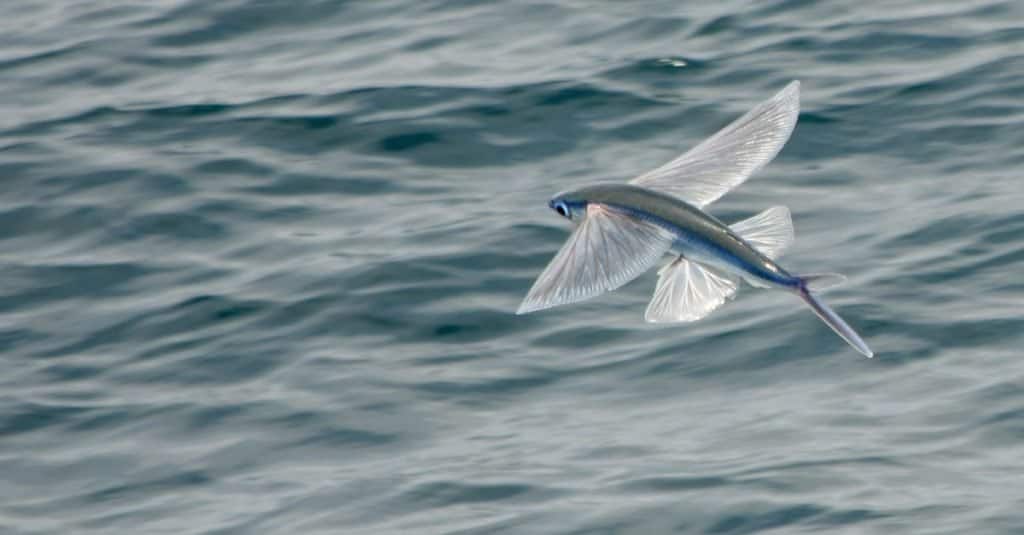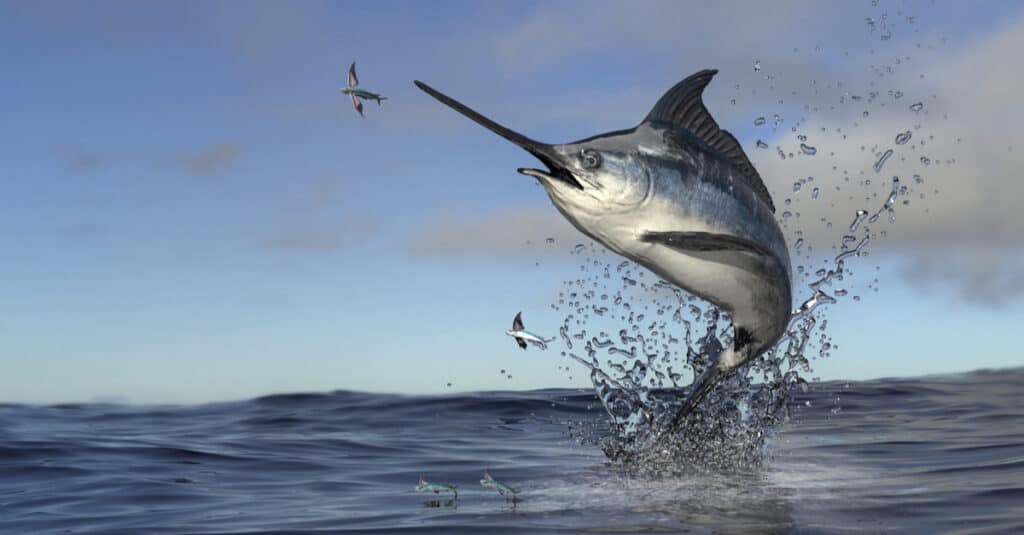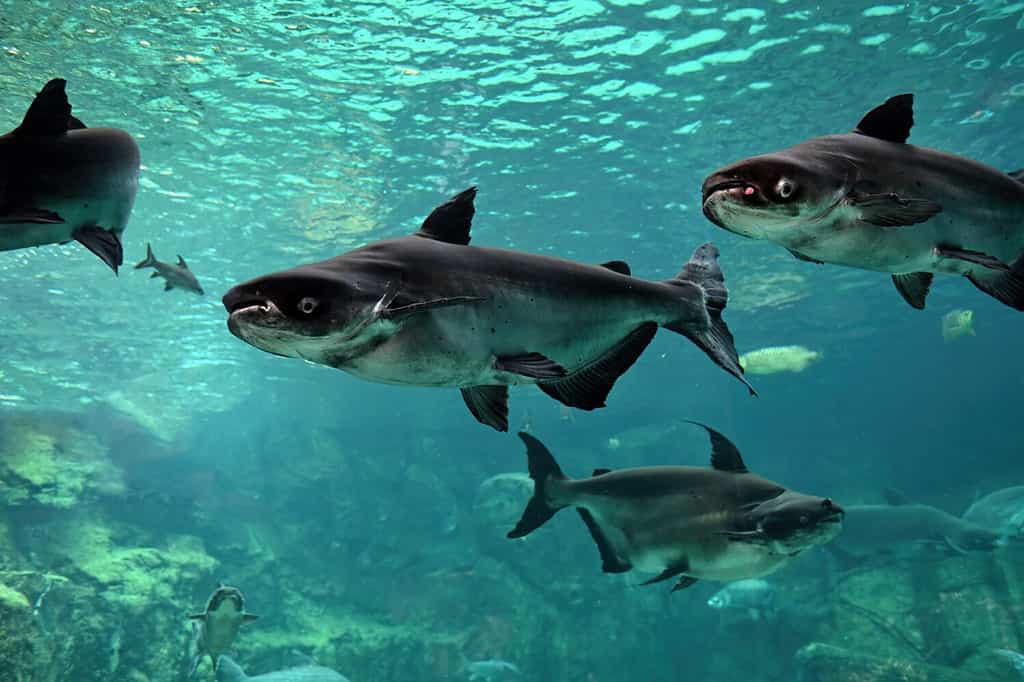Flying fish are incredible ocean fish that astonish seafarers with their power and flying ability. Flying fish gather so much speed they can launch themselves from the ocean and glide huge distances. From their astonishing speed to how young flying fish (fry) hide in the ocean to avoid predators, here are 10 incredible flying fish facts that will surprise you.

1. They Don’t Actually Fly

Flying Fish can glide for 45 seconds.
©Brent Barnes/Shutterstock.com
It’s a disappointment, but like the flying fox, flying fish can’t actually fly like birds do.
Buzz Lightyear’s ‘falling with style’ is a better way to describe what is in fact stylish gliding, without any flapping.
Flying fish have evolved large wing-shaped fins that enable gliding over distance and their maximum recorded distance is 655 feet! Ocean goers witness them exiting one side of a swell before entering another swell. Sometimes this can take 45 seconds, so it’s exciting to watch.
Flying fish acrobatics confused our Ancient Greek ancestors who named them Exocoetidae or ‘sleeping outside’ because they thought flying fish leaped from the water to sleep in boats.
Today, children use the tongue twister ‘Fly, flying fish, fly’ to practice their English language skills and learn more incredible flying fish facts.
2. They Fly To Avoid Predators

Birds feed on flying fish that exit the water at the wrong time.
©iStock.com/
Their flying ability most likely evolved so they could escape predators.
Flying fish predators include mackerel, tuna, swordfish, and marlin all of which are large fast fish. To escape them, flying fish gather speed and leap from the ocean, gliding into the air so they can’t be grabbed from behind.
Unfortunately, once in the air, they are prey to birds. Poor flying fish just can’t win. They feed a lot of other creatures and are an essential part of the ecosystem as a result.
3. Flying Fish Are Incredibly Fast

Flying fish can reach speeds of 56 kms an hour.
©Agami Photo Agency/Shutterstock.com
Flying fish are fast. They can reach phenomenal speeds of 56 kilometers an hour, utilizing their torpedo shape and vertically forked tail to fire themselves out of the water. For comparison, that’s about the same speed as a lion.
An article in the Journal of Experimental Biology suggests that flying fish have attracted lots of interest from biology and aerodynamics specialists due to their incredible physiology.
Although flying fish are relatively small, measuring only 2-20 inches in length, their astonishing speed means they pack a punch if they hit. They’re especially painful shoaling in their hundreds. Fishermen report it’s like being hit with a machine gun! Don’t worry though, although people have been injured by ‘flying fish’ that’s usually large fish leaping on the end of a line.
Interestingly, the ‘Exocet’ missile is named after the Exocoetidae group because they launch underwater and skim the surface. That’s quite an honor for the flying fish.
4. How To Catch A Flying Fish

Fishermen have used lights to lure flying fish.
©Carl Banks Photography/Shutterstock.com
Given their ability to fly, you’d think it would be hard to catch flying fish, but it’s actually easy if you’re a human.
Flying fish are attracted to light as many ocean animals are. For thousands of years, fishermen have used light as a lure. A canoe filled with water with a luring light attached is enough to make plenty of flying fish leap into the canoe. Once they’re in, they can’t get enough speed to leap out.
Flying fish are a delicacy in up-market restaurants so they are always in demand.
5. Flying Fish Are Good Luck Symbols

Flying fish can be known as a good luck symbol in dreams.
©iStock.com/cyano66
In some cultures, the flying fish is a symbol of good luck and in dreams they signify discovering new paths. Success, favorable circumstances, and blessings are all associated with this little fish.
Let’s hope one pops up in a dream tonight!
6. They Have Mass Breeding Orgies!

The flying fish mating process can last for two hours.
©Daniel Huebner/Shutterstock.com
Flying fish spawn in the open ocean. Females attach eggs to floating debris such as leaves and males aim sperm at the eggs. When enough eggs are attached, the debris floats to the ocean floor.
Mating takes place in the warmer months and fishermen have witnessed mass breeding events of flying fish jumping, flying, and swimming together. As they move their eggs and sperm are flung about. One such event in the Gulf of Mexico involved over a million flying fish in a mating orgy that lasted for two hours.
It’s not too surprising given other mass spawning events such as the trillions of eggs that are released in the Great Barrier Reef of Australia during the full moon.
7. Incredible Baby Flying Fish Don a Disguise

Marlin prey on flying fish who leap from the water to escape.
©bekirevren/Shutterstock.com
Most flying fish eggs are eaten by predators, but those that do survive adopt a cunning disguise to hide from other fish interested in eating them.
Newly hatched flying fish are called fry and they have whiskers around their mouths that disguise them as plants!
Going incognito is an ingenious way to stay safe in the dangerous ocean. Once they develop those amazing gliding fins, they drop the beard and make their escape in the open air.
8. Barbados Was Called the Land of the Flying Fish

Barbados is known as The Land of the Flying Fish.
©iStock.com/pavlofox
The Caribbean Sea is home to abundant amounts of flying fish. There are so many they’ve become the official Bajan national dish. Although flying fish are not endangered, the corals of Bridgetown are so damaged by pollution and large-scale fishing vessels that they are not common there any longer.
Still, flying fish can be seen on the Barbadian passport, coins, coats-of-arms, and statues. It’s still known as ‘The Land of the Flying Fish’.
9. Flying Fish Are Impossible To Keep In An Aquarium

Flying fish are built to escape enclosures like aquariums.
©tristan tan/Shutterstock.com
If you want to see flying fish for yourself, it’ll mean a trip to the ocean. They’re almost impossible to keep in an aquarium for obvious reasons!
In the past, a few water parks have attempted it, but because flying fish need space to gather speed, they failed to fly and amuse the paying guests.
Some fish-keepers have aquariums of the flying fox fish which is a South-East Asian species. However, they are freshwater bottom feeders that don’t fly, they’re just similar in appearance.
10. Flying Fish Are More Incredible Than The Wright Brothers

Wilbur and Orville Wright achieved the first successful airplane flights in 1903, which lasted 12 seconds.
©iStock.com/imagewerks
Our tenth incredible flying fish fact is they are better than the Wright Brothers!
The Wright Brothers first flight lasted 12 seconds and traveled 180 feet. A flying fish was recorded flying for 45 seconds, so that’s almost four times as long!
And not only that, flying fish can travel up to 650 feet in one sustained glide. Perhaps if the Wright Brothers were chased, they’d have matched a flying fish.
So, there we have 10 incredible flying fish facts. These little torpedoes are an essential part of the ocean eco-system. They provide sustenance for many ocean dwellers, but it’s hard not to feel for them as they leap away from danger.
Fly, flying fish, fly!
The photo featured at the top of this post is © Channarong Pherngjanda/Shutterstock.com
Thank you for reading! Have some feedback for us? Contact the AZ Animals editorial team.






